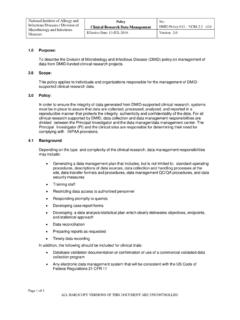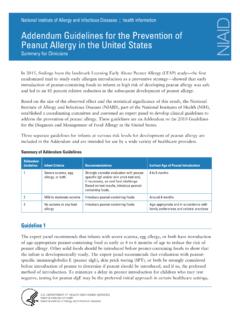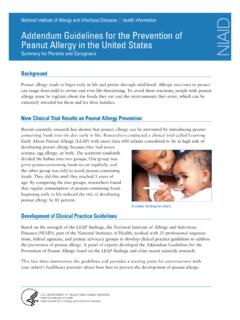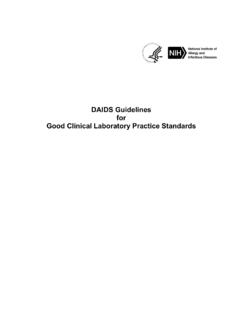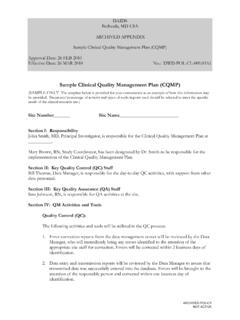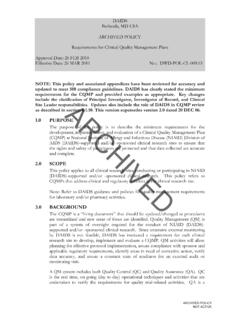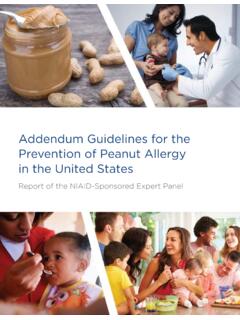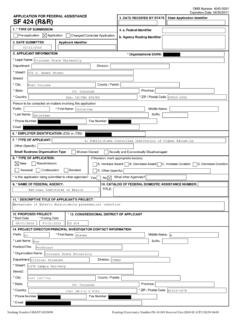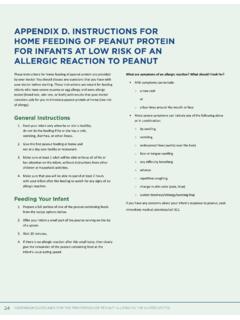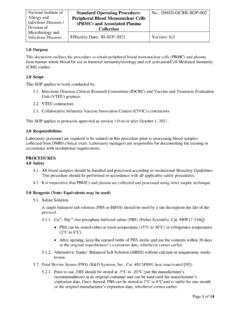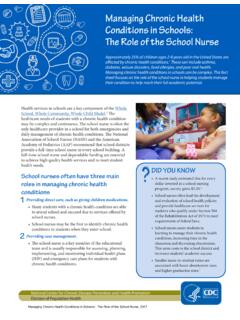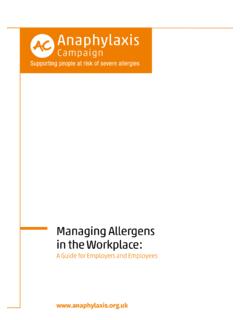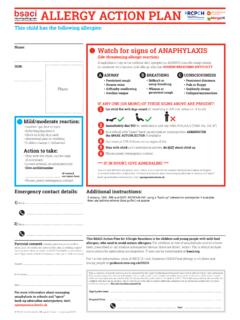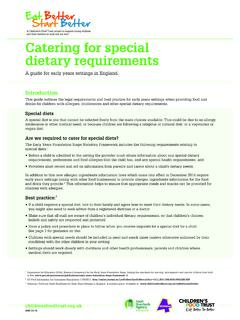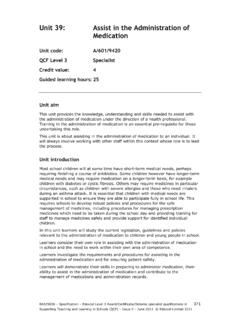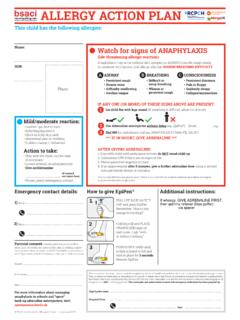Transcription of Guidelines for the Diagnosis and Management of Food ...
1 NIAIDG uidelines for the Diagnosis and Management of food Allergy in the United States Summary for Patients, Families, and Caregivers National Institute of Allergy and Infectious Diseases DEPARTMENT OF HEALTH AND HUMAN SERVICES National Institutes of Health National Institute of Allergy and Infectious Diseases Guidelines for the Diagnosis and Management of food Allergy in the United States Summary for Patients, Families, and Caregivers DEPARTMENT OF HEALTH AND HUMAN SERVICES National Institutes of Health National Institute of Allergy and Infectious Diseases NIH Publication No. 11-7699 May 2011 CONTENTS Contents 4 6 9 19 25 29 30 Introduction food Allergy, Prevalence, and Associated Disorders Diagnosis of food Allergy Management of Nonacute Allergic Reactions and Prevention of food Allergy Diagnosis and Management of Anaphylaxis Caused by food Sample Anaphylaxis Emergency Action Plan Glossary* * Note: Words in blue throughout the text are defined in the glossary.
2 NIAID I SUMMARY FOR PATIENTS, FAMILIES, AND CAREGIVERS 3 NIAID I Guidelines FOR ThE Diagnosis AND Management OF food ALLERGY IN ThE UNITED STATES 4 INTRODUCTION Introduction Most of us eat without a thought that something so essential to life might also harm us. But for people who are allergic to one or more foods, every mouthful can be a worry. Although allergic reactions to food can be mild, they also may be severe, leading to a life-threatening allergic reaction called anaphylaxis. The Guidelines for the Diagnosis and Management of food Allergy in the United States: Report of the NIAID-Sponsored Expert Panel were written to provide healthcare professionals with the most up-to-date clinical advice on how to care for their patients with food allergy. How were the Guidelines developed? The Guidelines are the culmination of a 2-year effort in which the National Institute of Allergy and Infectious Diseases (NIAID), part of the National Institutes of Health, worked with 34 professional organizations, federal agencies, and patient advocacy groups.
3 A panel of experts from a variety of clinical backgrounds developed the Guidelines based on a review and evaluation of recent scientific publications about food allergy. The Guidelines are intended to help healthcare professionals make appropriate decisions about patient care; however, it is vital that patients, families, and caregivers understand what the Guidelines say about managing food allergy. What else you should know: The Guidelines are not an official regulatory document of any government agency. They are intended as a resource to guide clinical practice and to help develop educational materials for patients, their families and caregivers, and the public. They do not override your doctor s responsibility to make decisions appropriate to your circumstances. If you want to read more about how the Guidelines were developed, visit NIAID s food allergy Guidelines Web site at foodallergy/clinical. NIAID I SUMMARY FOR PATIENTS, FAMILIES, AND CAREGIVERS 5 INTRODUCTION What do the Guidelines tell your doctor?
4 The Guidelines include definitions of food allergy and related disorders, recommendations on how to diagnose and manage food allergy, and ways to diagnose and manage severe and life-threatening allergic reactions to food . What does this booklet tell you? This booklet summarizes the most important information from the Guidelines and provides a starting point for patient-doctor conversations about food allergy. We hope that this information will empower patients, families, and caregivers with the knowledge they need to manage the disorder and, in turn, experience a better quality of life. There are 43 Guidelines , and each includes the word recommends or suggests. These words convey the strength of the guideline, defined as follows: Recommend is used when the expert panel strongly recommended for or against a particular course of action. Suggest is used when the expert panel recommended weakly for or against a particular course of action. The reason for this was usually the lack of strong evidence to support a recommendation.
5 What the Guidelines do not do The Guidelines do not discuss celiac disease because there are existing clinical Guidelines for celiac disease. The Guidelines also do not address the Management of people with food allergy outside of clinical care settings (for example, in schools and restaurants) or the related public health policy issues (for example, laws about food processing or food handling). NIAID I Guidelines FOR ThE Diagnosis AND Management OF food ALLERGY IN ThE UNITED STATES 6 food ALLERGY, PREVALENCE, AND ASSOCIATED DISORDERS food Allergy, Prevalence, and Associated Disorders What is food allergy? A food allergy is an adverse health effect arising from a specific immune response that occurs reproducibly on exposure to a given food . food allergens are the parts of food or ingredients within food (usually proteins) that are recognized by immune cells. When an immune cell binds to a food allergen, a reaction occurs that causes the symptoms of food allergy.
6 What else you should know: Most food allergens cause reactions even after they have been cooked or digested. Some allergens, most often from fruits and vegetables, cause allergic reactions only when eaten raw. food oils, such as soy, corn, peanut, and sesame, may or may not be allergenic (causing allergy), depending on how they are processed. Allergy and allergic disease refer to conditions that involve changes to your immune system. These immune system changes fall into two categories: Immunoglobulin E (IgE) mediated the symptoms are the result of interaction between the allergen and a type of antibody known as IgE, which is thought to play a major role in allergic reactions Non-IgE-mediated the symptoms are the result of interaction of the allergen with the immune system, but the interaction does not involve an IgE antibody If you are sensitized to a food allergen, it means that your body has made a specific IgE (sIgE) antibody to that food allergen, but you may or may not have symptoms of food allergy.
7 If you can consistently tolerate a food that once caused you to have an allergic reaction, you have outgrown the food allergy. food intolerances are adverse health effects caused by foods. They do not involve the immune system. For example, if you are lactose intolerant, you are missing the enzyme that breaks down lactose, a sugar found in milk. NIAID I SUMMARY FOR PATIENTS, FAMILIES, AND CAREGIVERS 7 food ALLERGY, PREVALENCE, AND ASSOCIATED DISORDERS How common is food allergy? A 2007 survey conducted by the Centers for Disease Control and Prevention estimated that food allergy affects 5 percent of children under the age of 5 and 4 percent of children aged 5 to 17 years and adults in the United States. There are eight major food allergens in the United States milk, egg, peanut, tree nuts, soy, wheat, fish, and crustacean shellfish. Prevalence rates in the United States for some of these food allergens are provided below: Peanut: percent Tree nuts: percent Fish: percent in children and percent in adults Crustacean shellfish (crab, crayfish, lobster, shrimp): percent in children and percent in adults All seafood: percent in children and percent in adults Milk and egg: no reliable data available from studies, but based on data obtained outside the United States, this rate is likely to be 1 2 percent for young children Can food allergy be outgrown?
8 Most children eventually outgrow milk, egg, soy, and wheat allergy. Fewer children outgrow peanut and tree nuts allergy. Outgrowing a childhood allergy may occur as late as the teenage years. For many children, sIgE antibodies can be detected within the first 2 years of life. A child with a high initial level of sIgE, along with clinical symptoms of food allergy, is less likely to outgrow the allergy. A decrease in sIgE antibodies is often associated with outgrowing the allergy. food allergy also can begin in adulthood. Late-developing food allergy tends to persist. What other conditions can occur with food allergy? If someone has food allergy, he or she is more likely to have asthma, eczema, eosinophilic esophagitis (EoE), or exercise-induced anaphylaxis. NIAID I Guidelines FOR ThE Diagnosis AND Management OF food ALLERGY IN ThE UNITED STATES 8 food ALLERGY, PREVALENCE, AND ASSOCIATED DISORDERS What are risk factors for severe allergic reactions to foods?
9 The severity of allergic reactions to foods is based on many different factors, including how much you ate and whether the food was cooked, raw, or processed. You cannot tell how severe your next allergic reaction will be based on the severity of your previous reactions. No available tests can predict how severe a future allergic reaction will be. You are more likely to have a severe allergic reaction to food if you also have asthma. NIAID I SUMMARY FOR PATIENTS, FAMILIES, AND CAREGIVERS 9 Diagnosis OF food ALLERGY Diagnosis of food Allergy When should your healthcare professional suspect food allergy? Guideline 1 recommends that your healthcare professional should consider the Diagnosis of food allergy If you are experiencing anaphylaxis, a severe allergic reaction to food that involves more than one body system (for example, skin and respiratory tract and/or gastrointestinal (GI) tract). If you are experiencing a combination of symptoms within minutes to hours after eating food and/or after eating a specific food on more than one occasion.
10 See table A for a list of allergic symptoms caused by food . If you have been diagnosed with EoE. In an infant or child diagnosed with moderate to severe eczema, EoE, enterocolitis, enteropathy, or allergic proctocolitis. What else you should know: food -allergic reactions may be IgE-mediated, non-IgE-mediated, or both. Your healthcare professional needs to identify the type of reaction so he or she can select the correct diagnostic test(s). Milk, egg, and peanut account for the vast majority of IgE-mediated reactions in young children, whereas peanut, tree nuts, and seafood (fish and crustacean shellfish) account for the vast majority of IgE-mediated reactions in teenagers and adults. The symptoms of an IgE-mediated food allergy almost always occur immediately after eating the food . However, an allergic reaction may not occur after exposure if a very small amount of the food is eaten or if the food , such as milk or egg, is extensively heated on the stovetop or baked in the oven.
